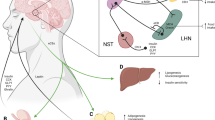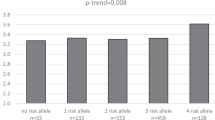Abstract
Background
The development of obesity has a large genetic component, and the gene encoding the transcription factor 2 beta (TFAP2B) has been identified as one of the responsible factors. We investigated the effect of TFAP2B intron 2 variable number tandem repeat (VNTR) genotype on obesity, insulin resistance and dietary intake from 15 to 33 years of age.
Methods
The sample included both birth cohorts (originally n = 1176) of the longitudinal Estonian Children Personality Behaviour and Health Study. The association between TFAP2B genotype, and anthropometric measurements, glucose metabolism and dietary intake at ages 15, 18 and 25 years was assessed using the linear mixed-effects regression models. Differences in anthropometric measurements, biochemical measures, blood pressure and dietary intake between TFAP2B genotypes at different age, including data of the older cohort at age 33, were assessed by one-way ANOVA.
Results
Male homozygotes for the TFAP2B 5-repeat allele had significantly higher body weight, body mass index, sum of 5 skinfolds, proportion of body fat, waist circumference, hip circumference, waist-to-hip ratio, waist-to-height ratio, fasting insulin and HOMA index. In female subjects, homozygotes for the TFAP2B 5-repeat allele had significantly larger increase in the rate of change per year in body weight, body mass index and hip circumference between years 15 and 25. By age 33, the findings were similar. A decrease in daily energy intake from adolescence to young adulthood was observed. In males, heterozygotes had significantly smaller decrease in the rate of change per year in daily energy intake.
Conclusions
The association of TFAP2B with the development of obesity and insulin resistance is present throughout adolescence to young adulthood in males. In females the effect of TFAP2B on obesity appears later, in young adulthood. The TFAP2B effect is rather related to differences in metabolism than energy intake.
This is a preview of subscription content, access via your institution
Access options
Subscribe to this journal
Receive 12 print issues and online access
$259.00 per year
only $21.58 per issue
Buy this article
- Purchase on Springer Link
- Instant access to full article PDF
Prices may be subject to local taxes which are calculated during checkout




Similar content being viewed by others
References
Midthjell K, Lee CMY, Langhammer A, Krokstad S, Holmen TL, Hveem K, et al. Trends in overweight and obesity over 22 years in a large adult population: the HUNT Study, Norway. Clin Obes. 2013;3:12–20.
GBD 2015 Obesity Collaborators, Afshin A, Forouzanfar MH, Reitsma MB, Sur P, Estep K, et al. Health effects of overweight and obesity in 195 countries over 25 years. N Engl J Med. 2017;377:13–27.
Freedman DS, Ford ES. Are the recent secular increases in the waist circumference of adults independent of changes in BMI? Am J Clin Nutr. 2015;101:425–31.
Bhupathiraju SN, Hu FB. Epidemiology of obesity and diabetes and their cardiovascular complications. Circ Res. 2016;118:1723–35.
Bell CG, Walley AJ, Froguel P. The genetics of human obesity. Nat Rev Genet. 2005;6:221–34.
Rokholm B, Silventoinen K, Tynelius P, Gamborg M, Sørensen TIA, Rasmussen F. Increasing genetic variance of body mass index during the Swedish obesity epidemic. PLoS ONE. 2011;6:e27135.
Silventoinen K, Rokholm B, Kaprio J, Sørensen TIA. The genetic and environmental influences on childhood obesity: a systematic review of twin and adoption studies. Int J Obes. 2010;34:29–40.
Nordquist N, Göktürk C, Comasco E, Eensoo D, Merenäkk L, Veidebaum T, et al. The transcription factor TFAP2B is associated with insulin resistance and adiposity in healthy adolescents. Obesity. 2009;17:1762–7.
Locke AE, Kahali B, Berndt SI, Justice AE, Pers TH, Day FR, et al. Genetic studies of body mass index yield new insights for obesity biology. Nature. 2015;518:197–206.
Felix JF, Bradfield JP, Monnereau C, van der Valk RJP, Stergiakouli E, Chesi A, et al. Genome-wide association analysis identifies three new susceptibility loci for childhood body mass index. Hum Mol Genet. 2016;25:389–403.
Tsukada S, Tanaka Y, Maegawa H, Kashiwagi A, Kawamori R, Maeda S. Intronic polymorphisms within TFAP2B regulate transcriptional activity and affect adipocytokine gene expression in differentiated adipocytes. Mol Endocrinol. 2006;20:1104–11.
Ikeda K, Maegawa H, Ugi S, Tao Y, Nishio Y, Tsukada S, et al. Transcription factor activating enhancer-binding protein-2beta. A negative regulator of adiponectin gene expression. J Biol Chem. 2006;281:31245–53.
Tao Y, Maegawa H, Ugi S, Ikeda K, Nagai Y, Egawa K, et al. The transcription factor AP-2beta causes cell enlargement and insulin resistance in 3T3-L1 adipocytes. Endocrinology. 2006;147:1685–96.
Harro M, Eensoo D, Kiive E, Merenäkk L, Alep J, Oreland L, et al. Platelet monoamine oxidase in healthy 9- and 15-years old children: the effect of gender, smoking and puberty. Prog Neuropsychopharmacol Biol Psychiatry. 2001;25:1497–511.
Kiive E, Laas K, Vaht M, Veidebaum T, Harro J. Stressful life events increase aggression and alcohol use in young carriers of the GABRA2 rs279826/rs279858 A-allele. Eur Neuropsychopharmacol. 2017;27:816–27.
Durnin JV, Womersley J. Body fat assessed from total body density and its estimation from skinfold thickness: measurements on 481 men and women aged from 16 to 72 years. Br J Nutr. 1974;32:77–97.
Durnin JVGA, Rahaman MM. The assessment of the amount of fat in the human body from measurements of skinfold thickness. Br J Nutr. 1967;21:681–9.
Matthews DR, Hosker JP, Rudenski AS, Naylor BA, Treacher DF, Turner RC. Homeostasis model assessment: insulin resistance and beta-cell function from fasting plasma glucose and insulin concentrations in man. Diabetologia. 1985;28:412–9.
Haapa E, Toponen T, Pietinen P, Räsänen L Annoskuvakirja. Helsingi: Kansanterveyslaitas; 1985.
Detry MA, Ma Y. Analyzing repeated measurements using mixed models. JAMA. 2016;315:407–8.
Lindgren CM, Heid IM, Randall JC, Lamina C, Steinthorsdottir V, Qi L, et al. Genome-wide association scan meta-analysis identifies three Loci influencing adiposity and fat distribution. PLoS Genet. 2009;5:e1000508.
Speliotes EK, Willer CJ, Berndt SI, Monda KL, Thorleifsson G, Jackson AU, et al. Association analyses of 249,796 individuals reveal 18 new loci associated with body mass index. Nat Genet. 2010;42:937–48.
Guo Y, Lanktree MB, Taylor KC, Hakonarson H, Lange LA, Keating BJ, et al. Gene-centric meta-analyses of 108 912 individuals confirm known body mass index loci and reveal three novel signals. Hum Mol Genet. 2013;22:184–201.
Berndt SI, Gustafsson S, Mägi R, Ganna A, Wheeler E, Feitosa MF, et al. Genome-wide meta-analysis identifies 11 new loci for anthropometric traits and provides insights into genetic architecture. Nat Genet. 2013;45:501–12.
Seyednasrollah F, Mäkelä J, Pitkänen N, Juonala M, Hutri-Kähönen N, Lehtimäki T, et al. Prediction of adulthood obesity using genetic and childhood clinical risk factors in the cardiovascular risk in young finns study. Circ Cardiovasc Genet. 2017;10:e001554.
Nelson MC, Gordon-Larsen P, North KE, Adair LS. Body mass index gain, fast food, and physical activity: effects of shared environments over time. Obesity. 2006;14:701–9.
Lajunen H-R, Kaprio J, Keski-Rahkonen A, Rose RJ, Pulkkinen L, Rissanen A, et al. Genetic and environmental effects on body mass index during adolescence: a prospective study among Finnish twins. Int J Obes. 2009;33:559–67.
Graff M, North KE, Richardson AS, Young KL, Mazul AL, Highland HM, et al. BMI loci and longitudinal BMI from adolescence to young adulthood in an ethnically diverse cohort. Int J Obes. 2017;41:759–68.
Graff M, Ngwa JS, Workalemahu T, Homuth G, Schipf S, Teumer A, et al. Genome-wide analysis of BMI in adolescents and young adults reveals additional insight into the effects of genetic loci over the life course. Hum Mol Genet. 2013;22:3597–607.
Eckert D, Buhl S, Weber S, Jäger R, Schorle H. The AP-2 family of transcription factors. Genome Biol. 2005;6:246.1–8.
Damberg M, Garpenstrand H, Alfredsson J, Ekblom J, Forslund K, Rylander G, et al. A polymorphic region in the human transcription factor AP-2beta gene is associated with specific personality traits. Mol Psychiatry. 2000;5:220–4.
Damberg M, Eller M, Tõnissaar M, Oreland L, Harro J. Levels of transcription factors AP-2alpha and AP-2beta in the brainstem are correlated to monoamine turnover in the rat forebrain. Neurosci Lett. 2001;313:102–4.
Comasco E, Iliadis SI, Larsson A, Olovsson M, Oreland L, Sundström-Poromaa I, et al. Adipocytokines levels at delivery, functional variation of TFAP2β, and maternal and neonatal anthropometric parameters. Obesity. 2013;21:2130–7.
Maeda S, Tsukada S, Kanazawa A, Sekine A, Tsunoda T, Koya D, et al. Genetic variations in the gene encoding TFAP2B are associated with type 2 diabetes mellitus. J Hum Genet. 2005;50:283–92.
Maeda S, Osawa N, Hayashi T, Tsukada S, Kobayashi M, Kikkawa R. Genetic variations associated with diabetic nephropathy and type II diabetes in a Japanese population. Kidney Int Suppl. 2007;72:S43–8.
Remy E, Issanchou S, Chabanet C, Boggio V, Nicklaus S. Impact of adiposity, age, sex and maternal feeding practices on eating in the absence of hunger and caloric compensation in preschool children. Int J Obes. 2015;39:925–30.
Wardle J, Haase AM, Steptoe A, Nillapun M, Jonwutiwes K, Bellisle F. Gender differences in food choice: the contribution of health beliefs and dieting. Ann Behav Med. 2004;27:107–16.
Chowen JA, Freire-Regatillo A, Argente J. Neurobiological characteristics underlying metabolic differences between males and females. Prog Neurobiol. 2019;176:18–32.
Asarian L, Geary N. Sex differences in the physiology of eating. Am J Physiol Regul Integr Comp Physiol. 2013;305:1215–67.
Acknowledgements
This study was supported by the Estonian Ministry of Education and Research (IUT20-40) and the European Commission Horizon 2020 Programme Projects CoCA (no 667302) and Eat2beNICE (no 728018). We are grateful to the participants of the ECPBHS and to the whole ECPBHS Study Team. Erika Comasco is a Marie Skłodowska Curie fellow and received funds from the Swedish Research Council (VR: 2015-00495), EU FP7-People-Cofund (INCA 600398) and SciLifeLab.
Author information
Authors and Affiliations
Corresponding author
Ethics declarations
Conflict of interest
The authors declare that they have no conflict of interest.
Additional information
Publisher’s note: Springer Nature remains neutral with regard to jurisdictional claims in published maps and institutional affiliations.
Supplementary information
Rights and permissions
About this article
Cite this article
Joost, U., Villa, I., Comasco, E. et al. Association between Transcription Factor AP-2B genotype, obesity, insulin resistance and dietary intake in a longitudinal birth cohort study. Int J Obes 43, 2095–2106 (2019). https://doi.org/10.1038/s41366-019-0396-y
Received:
Revised:
Accepted:
Published:
Issue Date:
DOI: https://doi.org/10.1038/s41366-019-0396-y
This article is cited by
-
The regulatory role of AP-2β in monoaminergic neurotransmitter systems: insights on its signalling pathway, linked disorders and theragnostic potential
Cell & Bioscience (2022)
-
Association between platelet MAO activity and lifetime drug use in a longitudinal birth cohort study
Psychopharmacology (2022)



